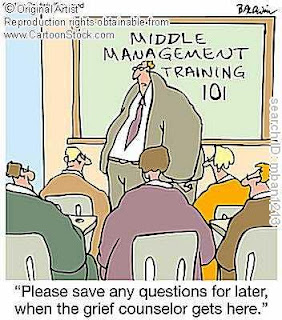
In a lot of organizations I work with, we need to do a better job of explaining Scrum to the middle managers.
Most of the people in the Teams get Scrum and see benefits. Most of the senior guys see their metrics get better, and, if they focus on the right feedback, hear and see good things.
But often the middle managers feel left out. Yes, they see benefits here and there, but often not for themselves. They should actually see benefits for themselves, but no one shows them how to realize those benefits. We just assume they will naturally, without any explanation, understand and adapt to, the change (to Scrum).
But, a common feeling among the middle managers is: 'Who moved my cheese?' (If you know that book.) Meaning: Before, I knew how to manage and be successful and show progress. Now, with Scrum, they moved all my levers. And how do I function successfully?
So, we need to take the time to explain it to them.
Here is a first, too quick, pass at that explanation. It is too simplistic, and too specific in assuming a prior waterfall process. But, a good start (I hope).
***
1. Your job has gotten better (not stupid).
Instead of doing something stupid (trying to manage individuals in a waterfall process), you now help teams get better in a more effective approach/framework (Scrum).
2. Your job has gotten better (clearly useful).
Instead of trying to show in waterfall that you did something truly useful (almost impossible to show, really), you now can see real progress in the success of the Scrum team. And working product (software) is a far better measure of real progress. As is team velocity.
3. Your job is different (remove impediments).
Instead of pushing the team to 'work harder', you now are a servant leader. Your main job is to help the team remove impediments.
Honestly, most of you removed impediments before. You just didn't call them that. And there was no clear way to prioritize them. Now, you get help from the team and more recognition (up and down).
For some of you, you get to join a Scrum team and lead the team in doing 'real work'. Which in general is more satisfying for most people. But for those of you who like the frustrating work of removing impediments, we have a clear, prioritized, long list of them. For you to help fix.
4. Your job is different (no command-and-control).
In almost all cases, we do not recommend the command-and-control style any more.
OK, maybe at most 1-in-20 of the guys in our shop are really lazy or fundamentally without good motivation. Yes, you can help re-purpose (ultimately, fire) those very few people.
And you can identify those people who also
appear to be de-motivated, and help them get through the past de-motivators we had around here, and connect to work they really want to do.
But mostly we want you to take the coaching, servant leader style with the team.
You will find that the coaching style is much more satisfying than the command-and-control style. And the people you work with will now mostly like you and appreciate your efforts to make help them better. Instead of ducking-and-diving to avoid you.
5. More truth.
With both the people below you and the people above you (well, we want to start moving away from the hierarchy metaphor, to a more flat organization, but for now....)...for both sides, the good news is everyone is talking the truth more.
This is much more satisfying.
Although, to be honest, in the short-term, and until we get more people understanding it, it can be painful and take more courage.
But in the long-term, it is better for everyone, including you, if we are all more honest. Our work of new product development is truly hard. We, of course, make lots of mistakes. (As all scientists who discover a new thing do.) We are trying as hard as we can to learn as fast as possible from our mistakes. None of us is perfect.
Each of us tends to have a typical, repetitive weakness (and, the good news: we now have a team that helps each of us avoid our own peculiar weakness(es)).
There is nothing particularly new about this; it was true in waterfall really. But we are now going to admit it more, top to bottom (as we say).
6. Career growth.
Because we will be more successful as a firm with this approach (Scrum...or at least so we fully expect), we will be more profitable as a firm. And so, your prospects for long-term career growth are better.
Assuming it is the style of 'play' that you are comfortable with. (To be honest, not every manager fits with the style of Scrum. Some are died-in-the-wool command and control managers...they should not be 'forced' to play Scrum. Although maybe they should be 'invited' to play their style at another firm.)
***
This is a start on what to explain to the middle managers. Even at the high level, we have left out a lot. Then the middle managers start to ask: OK, what do I specifically do? While some of the specifics will indeed be very specific to your organization, we can say more on that. And will in a future post.
PS. The excellent cartoon is by Mike Baldwin. Google him.
